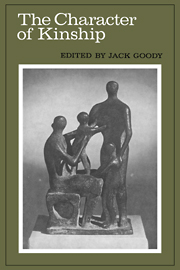Book contents
- Frontmatter
- Contents
- Dedication
- Introduction
- KINSHIP AND DESCENT
- THE NATURE OF KINSHIP
- THE NATURE OF THE FAMILY
- MARRIAGE AND AFFINAL ROLES
- Some Aspects of Levirate
- Polygyny, Economy and the Role of Women
- From Varna to Caste through Mixed Unions
- Bibliography of the Writings of Meyer Fortes
- References
- Index
From Varna to Caste through Mixed Unions
Published online by Cambridge University Press: 07 May 2010
- Frontmatter
- Contents
- Dedication
- Introduction
- KINSHIP AND DESCENT
- THE NATURE OF KINSHIP
- THE NATURE OF THE FAMILY
- MARRIAGE AND AFFINAL ROLES
- Some Aspects of Levirate
- Polygyny, Economy and the Role of Women
- From Varna to Caste through Mixed Unions
- Bibliography of the Writings of Meyer Fortes
- References
- Index
Summary
Introduction: Objectives
George Gay lord Simpson in Principles of Animal Taxonomy (1961) describes two forms of classification, namely hierarchy and key.
Hierarchy is a systematic framework with a sequence of classes at different levels in which each class except the lowest includes one or more subordinate classes. At each level from higher to lower there is a splitting or separating off into subordinate discrete classes. The Linnaean hierarchy of dividing into seven levels – kingdom, phylum, class, order, family, genus, and species – is a classical example. Or more simply, the bear (ursus) subdivided into brown bear and polar bear, etc. is an example of hierarchical taxonomy.
In contrast, a key is an arrangement produced by the overlap of classes: it is a systematic framework with a sequence of classes at each level of which more restricted classes are formed by the overlap of two or more classes at the next higher level. Thus two separate classes of animals such as horned mammals and two-toed mammals can by a process of overlap or mixture generate the class of horned two-toed mammals.
Conklin (1964) who distinguishes five methods of classification confirms the basic distinction between a taxonomic hierarchy (whose constituent taxa or entities are arranged vertically by non-dimensional class inclusion and whose hierarchic positions are not permutable) and a key which is a multidimensional and hence often permutable arrangement of attribute oppositions, which by their hierarchic application help to locate the entities being identified.
- Type
- Chapter
- Information
- The Character of Kinship , pp. 191 - 230Publisher: Cambridge University PressPrint publication year: 1974
- 7
- Cited by



